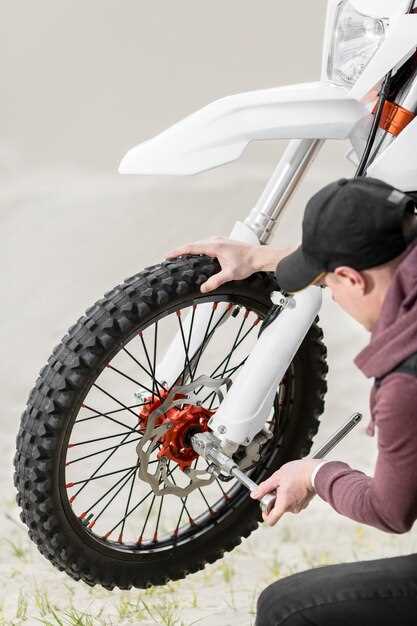
Choosing the right dirt bike tires is essential for optimizing performance across different terrains. The performance of your bike heavily depends on the tires you select, as they directly influence handling, traction, and overall ride quality. With a plethora of options available, it’s vital to understand the specific characteristics of tires suited for varying environments, from rocky trails to muddy paths.
Different terrains pose unique challenges for riders. For instance, muddy and soft surfaces require tires with deep treads to provide superior grip and prevent slippage. On the other hand, hardpack trails call for tires with a flatter profile for better stability and braking. Understanding these nuances will help you make an informed decision that enhances your biking experience.
Additionally, factors such as tire construction, rubber compounds, and tread patterns play critical roles in performance. Riders must consider not only the terrain they predominantly navigate but also their riding style and bike specifications. In this guide, we will explore the best dirt bike tires tailored for various terrains, ensuring that you can tackle any challenge with confidence and skill.
Understanding the Importance of Tire Selection for Off-Road Riding
Choosing the right tires for off-road riding is crucial for maximizing performance and ensuring safety. Tires are the only point of contact between the motorcycle and the terrain, making their selection paramount to the overall riding experience.
Traction is one of the key factors influenced by tire choice. Off-road terrains–ranging from muddy trails to rocky paths–require tires designed with specific tread patterns and rubber compounds that can grip varied surfaces. For instance, aggressive knobby tires provide optimal traction in loose dirt and mud, while flatter tires are better suited for hard-packed or rocky surfaces.
Handling is another critical aspect affected by tire selection. The right tires enhance a rider’s control over the motorcycle, which is essential on uneven and unpredictable terrains. With properly selected tires, riders can navigate obstacles with greater confidence and precision, reducing the risk of losing control.
The durability of tires also plays a vital role in off-road riding. Tires must withstand harsh conditions, including sharp rocks, roots, and abrasive surfaces. Choosing tires made from high-quality materials can prevent flats and extend tire life, which is especially beneficial for those who ride frequently in rugged environments.
Pressure adjustments can optimize tire performance on different terrains. A lower tire pressure increases the contact patch, providing better grip in soft conditions, while a higher pressure aids in stability and maneuverability on firmer ground. Understanding how to adjust tire pressure according to terrain is essential for maximizing performance.
In conclusion, selecting the right tires for off-road riding is not merely a matter of preference but a fundamental aspect that affects traction, handling, durability, and overall ride quality. Riders should carefully consider the type of terrain they frequently encounter to ensure they choose the best tires for their adventures.
Choosing Tires for Muddy Conditions: Key Features to Look For

When selecting tires for muddy conditions, it’s crucial to focus on specific features that enhance traction, stability, and overall performance. First and foremost, consider the tread pattern. A deeper and more aggressive tread design with large, widely spaced lugs is essential as it helps to channel mud away from the tire, preventing clogging and allowing for better grip.
Next, evaluate the tire rubber compound. Softer compounds typically offer increased flexibility and improved traction, making them ideal for navigating slippery and unstable surfaces. However, keep in mind that a balance must be struck, as softer tires may wear out more quickly on hard-packed or rocky terrains.
Additionally, pay attention to tire width. Wider tires provide a larger contact patch, improving floatation over soft surfaces, which is vital in muddy conditions. However, excessively wide tires can hinder maneuverability, so it’s essential to find a width that suits your riding style and terrain.
Another important aspect is the sidewall construction. Tires with reinforced sidewalls offer better puncture resistance and durability in harsh, muddy terrains. This feature is particularly beneficial when traversing through sharp rocks or debris hidden within the mud.
Finally, consider the tire pressure. Lowering the pressure enhances the tire’s footprint on the muddy ground, offering greater traction. However, be cautious not to go too low, as this can increase the risk of pinch flats. Adjusting tire pressure according to terrain conditions can significantly improve performance.
Selecting Tires for Rocky Terrain: Durability and Grip Considerations
When navigating rocky terrain, the choice of dirt bike tires is crucial for optimal performance and safety. Durability is a primary consideration since rocky environments can be abrasive and unforgiving. Tires designed specifically for rugged landscapes should feature reinforced sidewalls and puncture-resistant materials to withstand sharp rocks and harsh impacts. Look for tires with strong constructions, such as those utilizing high-durability rubber compounds, which enhance their lifespan and resilience against cuts and tears.
Grip is equally important in rocky conditions, as maintaining traction can significantly affect control and stability. Tires with deep, aggressive tread patterns are beneficial, as they provide enhanced grip on uneven surfaces. A combination of spaced lugs and softer rubber compounds allows for better contact with the ground, ensuring that the bike remains stable while navigating tough obstacles. Additionally, the tire profile can influence handling; a wider tire may offer more surface area for contact, improving stability on rocky paths.
Furthermore, it is essential to consider the tire’s tread design. Tires with multi-directional tread patterns can facilitate better traction on various types of rocks, including loose gravel and hard-packed surfaces. The right tire choice will promote self-cleaning capabilities, preventing mud and debris from accumulating in the tread, which can hinder performance. It’s advisable to test different tire models under actual riding conditions to determine their effectiveness in providing the desired grip and durability.
In summary, when selecting tires for rocky terrain, prioritize durability and grip. Opt for reinforced sidewalls, puncture-resistant materials, and advanced tread designs to ensure a safe and enjoyable riding experience. Proper tire selection not only enhances performance but also extends the lifespan of your dirt bike components, enabling you to tackle challenging trails with confidence.
Finding the Right Tires for Sand Dunes: Tread Patterns Explained
Selecting the appropriate tires for navigating sand dunes is crucial for optimizing performance and safety. The right tread pattern can dramatically affect traction, floatation, and control. Below are the key tread patterns to consider when choosing tires for sandy terrains.
- Rear Paddle Tires
- Designed with angled paddles that provide excellent traction in loose sand.
- Paddle tires “dig” into the sand, allowing for better acceleration and hill climbing.
- They often feature wider footprints to improve floatation and minimize sinking.
- Front Tires
- A lighter tread pattern to ensure better steering and control in soft sand.
- Often narrower than rear tires to reduce resistance and improve handling.
- May feature raised ribs or strakes for added directional stability.
- Hybrid Tires
- Combines characteristics of both paddle and traditional tires.
- Offers versatility for riders who venture between sand and other terrains.
- Typically includes a moderate tread depth to balance grip and floatation.
When selecting tires for riding in sand dunes, consider the following factors:
- Terrain Conditions
- Soft, loose sand requires more aggressive paddle designs.
- Compact, firmer sand allows for less aggressive tread patterns.
- Riding Style
- Competitive riders may prefer specialized paddle tires for maximum performance.
- Casual riders can opt for hybrid tires for all-terrain versatility.
- Bike Compatibility
- Ensure tire sizes match your bike’s specifications.
- Consider the bike’s weight and power output; heavier bikes may need more flotation.
In summary, choosing the right tire tread patterns for sand dunes can enhance your riding experience by providing the necessary grip and control. Assess your specific needs based on terrain, style, and bike compatibility to make an informed decision.
Best Tires for Hard-packed Trails: Balancing Comfort and Control
When navigating hard-packed trails, a dirt bike tire should provide an optimal blend of comfort, control, and durability. These surfaces can vary from compacted dirt to gravel, making it essential for tires to adapt effectively to different conditions while ensuring a smooth ride.
Hard-packed trails often feature a mix of terrain that requires tires with a balanced tread pattern. Ideally, these tires should have a moderate knob height for enhanced grip without sacrificing speed or stability. A well-designed tire can help maintain traction, allowing riders to take corners confidently while minimizing the chances of sliding.
To assist riders in selecting the best tires for hard-packed trails, we’ve compiled a table of top-rated options:
| Brand and Model | Tread Pattern | Size | Recommended Pressure (psi) | Key Features |
|---|---|---|---|---|
| Pirelli Scorpion MX Mid Hard | Intermediate | 80/100-21 | 12-14 | Excellent handling and durability, designed for mixed terrains. |
| Michelin StarCross 5 Hard | Directional | 90/100-21 | 12-15 | Superb grip, increased stability, and shock absorption. |
| Dunlop Geomax MX33 | Multi-directional | 80/100-21 | 13-15 | Versatile performance with excellent cornering capabilities. |
| Bridgestone Battlecross X30 | Mixed terrain | 90/100-21 | 12-14 | High traction, balanced performance on hard surfaces. |
In summary, when choosing tires for hard-packed trails, consider the terrain, your riding style, and tire specifications. The right tire will ensure that you experience both comfort and control, ultimately enhancing your riding experience on these challenging surfaces.
Evaluating Tire Brands and Models: What Riders Should Know Before Purchase
When selecting dirt bike tires, understanding the differences between brands and models is crucial for achieving optimal performance on various terrains. Each manufacturer offers unique technologies and designs that cater to specific riding styles and conditions. Therefore, riders should take several factors into account before making their purchase.
Brand Reputation plays a significant role in tire selection. Established brands often have a history of quality and durability. Researching reviews and experiences from fellow riders can provide insights into how a brand’s tires perform in real-world conditions. Look for brands that consistently receive positive feedback for traction, longevity, and performance.
Terrain Compatibility is another key consideration. Different tire models are designed for specific surfaces, such as mud, sand, or hardpack. For instance, knobby tires benefit off-road performance, delivering excellent grip in loose materials, while slick or semi-slick tires are better suited for hard surfaces. Identifying the terrain you’ll primarily be riding on will help narrow down the most suitable models.
Tread Design directly influences a tire’s performance characteristics. Aggressive tread patterns with deep knobs typically excel in loose or uneven conditions, providing better traction. Conversely, tighter patterns with fewer voids may be ideal for smoother trails, minimizing rolling resistance and enhancing speed. Evaluate your riding preferences and the types of tracks you’ll frequent to select the appropriate tread design.
Price vs. Performance is a balancing act every rider faces. While premium tires may offer advanced materials and innovative designs, it’s essential to consider your skill level and riding demands. For casual riders, mid-range options can provide sufficient performance without breaking the bank. However, serious racers may opt for higher-end tires for the performance benefits they offer.
Durability and Longevity should also be factored into your decision. Some tires are built with tougher materials that withstand wear from aggressive riding, while others may wear out quickly under similar conditions. Look for tires backed by long-lasting warranties or those that have proven track records in durability to ensure you’re making a wise investment.
Expert Recommendations often come from resources such as magazines, forums, and expert reviews. Engaging with dirt bike communities can yield personalized recommendations based on your specific needs. Riders often share their experiences with various models, helping you avoid potential pitfalls associated with lesser-known options.
In summary, evaluating tire brands and models requires careful consideration of reputation, terrain compatibility, tread design, price, durability, and expert opinions. By thoroughly analyzing these factors, riders can make informed choices that enhance their riding experience and optimize performance for the conditions they’ll face.

